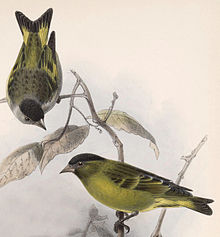Black-capped siskin
Appearance
| Black-capped siskin | |
|---|---|

| |

| |
| Male | |
| Scientific classification | |
| Domain: | Eukaryota |
| Kingdom: | Animalia |
| Phylum: | Chordata |
| Class: | Aves |
| Order: | Passeriformes |
| Family: | Fringillidae |
| Subfamily: | Carduelinae |
| Genus: | Spinus |
| Species: | S. atriceps
|
| Binomial name | |
| Spinus atriceps (Salvin, 1863)
| |

| |
| Synonyms | |
|
Carduelis atriceps | |
The black-capped siskin (Spinus atriceps) is a species of finch in the family Fringillidae. It is found in Guatemala and Mexico. Its natural habitats are subtropical or tropical moist montane forest and heavily degraded former forest.
Phylogeny
It has been obtained by Antonio Arnaiz-Villena et al.[2][3][4]
Identification
Spinus atriceps has been defined as a finch with a gray wash and a black cap.[5]However, other green morphs have been also identified with Spinus atriceps, but apparently they are pine siskin (S. pinus) green morphs.[5]
References
- ^ BirdLife International (2012). "Carduelis atriceps". IUCN Red List of Threatened Species. 2012. Retrieved 26 November 2013.
{{cite journal}}: Invalid|ref=harv(help) - ^ Zamora, J; Moscoso J; Ruiz-del-Valle V; Ernesto L; Serrano-Vela JI; Ira-Cachafeiro J; Arnaiz-Villena A (2006). "Conjoint mitochondrial phylogenetic trees for canaries Serinus spp. and goldfinches Carduelis spp. show several specific polytomies" (PDF). Ardeola. 53 (1): 1–17.
- ^ Arnaiz-Villena, A; Ruiz-del-Valle V; Moscoso J; Serrano-Vela JI; Zamora J (2007). "mtDNA phylogeny of North American Carduelis pinus group" (PDF). Ardeola. 54 (1): 1–14.
- ^ Arnaiz-Villena, A; Gómez-Prieto P; Ruiz-de-Valle V (2009). "Phylogeography of finches and sparrows". Animal Genetics. Nova Science Publishers. ISBN 978-1-60741-844-3. Archived from the original on 2 September 2012. Retrieved 5 December 2014.
- ^ a b Arnaiz-Villena, A; Areces, C; Rey, D; Enríquez-de-Salamanca, M; Alonso-Rubio, J; Ruiz-del-Valle, V (2012). "Three Different North American Siskin/Goldfinch Evolutionary Radia-tions (Genus Carduelis): Pine Siskin Green Morphs and European Siskins in America". The Open Ornithology Journal. 5: 73–81. doi:10.2174/1874453201205010073.

